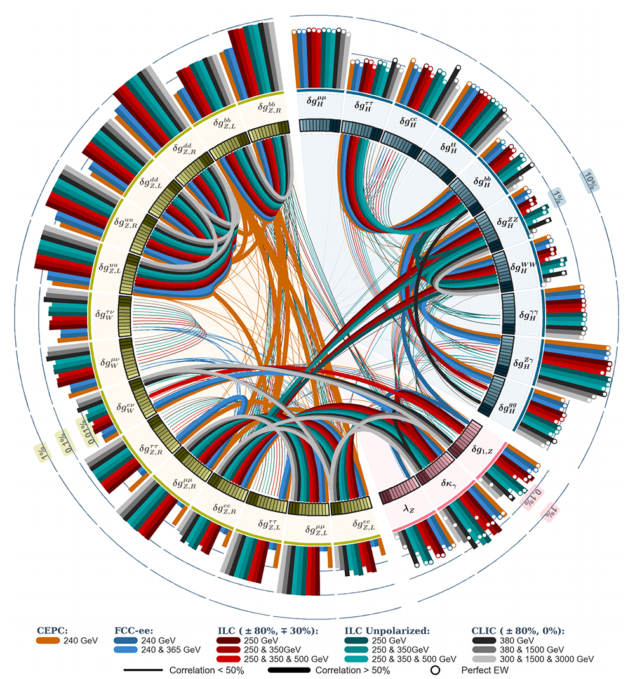
precisions (outer ring) for modified Higgs and electroweak couplings at candidate next-generation e+e– colliders (arXiv:1907.04311). Many correlations vanish when hadron-collider results are added. Credit: J de Blas et al.
Physics beyond the Standard Model must exist, to account for dark matter, the smallness of neutrino masses and the dominance of matter over antimatter in the universe; but we have no real clue of its energy scale. It is also widely recognised that new and more precise tools will be needed to be certain that the 125 GeV boson discovered in 2012 is indeed the particle postulated by Brout, Englert, Higgs and others to have modified the base potential of the whole universe, thanks to its coupling to itself, liberating energy for the masses of the W and Z bosons.
To tackle these big questions, and others, the Future Circular Collider (FCC) study, launched in 2014, proposed the construction of a new 100 km circular tunnel to first host an intensity-frontier 90 to 365 GeV e+e– collider (FCC-ee), and then an energy-frontier (> 100 TeV) hadron collider, which could potentially also allow electron–hadron collisions. Potentially following the High-Luminosity LHC in the late 2030s, FCC-ee would provide 5 × 1012 Z decays – over five orders of magnitude more than the full LEP era, followed by 108 W pairs, 106 Higgs bosons (ZH events) and 106 top-quark pairs. In addition to providing the highest parton centre-of-mass energies foreseeable today (up to 40 TeV), FCC-hh would also produce more than 1013 top quarks and W bosons, and 50 billion Higgs bosons per experiment.
Rising to the challenge
Following the publication of the four-volume conceptual design report and submissions to the European strategy discussions, the third FCC Physics and Experiments Workshop was held at CERN from 13 to 17 January, gathering more than 250 participants for 115 presentations, and establishing a considerable programme of work for the coming years. Special emphasis was placed on the feasibility of theory calculations matching the experimental precision of FCC-ee. The theory community is rising to the challenge. To reach the required precision at the Z-pole, three-loop calculations of quantum electroweak corrections must include all the heavy Standard Model particles (W±, Z, H, t).
In parallel, a significant focus of the meeting was on detector designs for FCC-ee, with the aim of forming experimental proto-collaborations by 2025. The design of the interaction region allows for a beam vacuum tube of 1 cm radius in the experiments – a very promising condition for vertexing, lifetime measurements and the separation of bottom and charm quarks from light-quark and gluon jets. Elegant solutions have been found to bring the final-focus magnets close to the interaction point, using either standard quadrupoles or a novel magnet design using a superposition of off-axis (“canted”) solenoids. Delegates discussed solutions for vertexing, tracking and calorimetry during a Z-pole run at FCC-ee, where data acquisition and trigger electronics would be confronted with visible Z decays at 70 kHz, all of which would have to be recorded in full detail. A new subject was π/K/p identification at energies from 100 MeV to 40 GeV – a consequence of the strategy process, during which considerable interest was expressed in the flavour-physics programme at FCC-ee.
Physicists cannot refrain from investigating improvements
The January meeting showed that physicists cannot refrain from investigating improvements, in spite of the impressive statistics offered by the baseline design of FCC-ee. Increasing the number of interaction points from two to four is a promising way to nearly double the total delivery of luminosity for little extra power consumption, but construction costs and compatibility with a possible subsequent hadron collider must be determined. A bolder idea discussed at the workshop aims to improve both luminosity (by a factor of 10) and energy reach (perhaps up to 600 GeV), by turning FCC-ee into a 100 km energy-recovery linac. The cost, and how well this would actually work, are yet to be established. Finally, a tantalising possibility is to produce the Higgs boson directly in the s-channel: e+e– → H, sitting exactly at a centre-of-mass energy equal to that of the Higgs boson. This would allow unique access to the tiny coupling of the Higgs boson to the electron. As the Higgs width (4.2 MeV in the Standard Model) is more than 20 times smaller than the natural energy spread of the beam, this would require a beam manipulation called monochromatisation and a careful running procedure, which a task force was nominated to study.
The ability to precisely probe the self-coupling of the Higgs boson is the keystone of the FCC physics programme. As said above, this self-interaction is the key to the electroweak phase transition, and could have important cosmological implications. Building on the solid foundation of precise and model-independent measurements of Higgs couplings at FCC-ee, FCC-hh would be able to access Hμμ, Hγγ, HZγ and Htt couplings at sub-percent precision. Further study of double Higgs production at FCC-hh shows that a measurement of the Higgs self-coupling could be done with a statistical precision of a couple of percent with the full statistics – which is to say that after the first few years of running the precision will already have been reduced to below 10%. This is much faster than previously realised, and definitely constituted the highlight of the workshop







